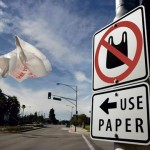Should we be able to cause major environmental damage just because it is convenient? Individuals purchasing bottled water seem to think so. In addition to harming our world, water bottles can cause risks to human health, are a waste of money, and are a drain on water and energy sources. Colleges and universities all over the country are recognizing this and as of 2012, more than 90 schools either banned or restricted the sale of plastic water bottles on campus. To continue sustainability efforts, Duke University should take similar action, banning these bottles and encouraging the use of reusable water bottles and existing water fountains and hydration stations.

Source: http://www.shopdukestores.duke.edu/webitemimages/106/65495.jpg
Despite attempts to encourage recycling, 38 billion water bottles, or 80% of bottles purchased, end up in landfills each and every year. This wouldn’t be so horrifying if it weren’t for the fact that waste from these products never really goes away. The bottles that we get rid of, end up poisoning us. Because most water bottles are made of petroleum-based polyethylene terephthalate (also known as PET), they break down through photodegradation into smaller and smaller pieces instead of biodegrading. This does not frequently happen in landfills since bottles are not likely to be exposed to the sun. However, ten percent of plastic (3.8 billion water bottles annually) ends up in the ocean as a result of trash being deposited in waterways by humans, wind, and heavy rains. Once exposed to sunlight, breakdown of these plastics results in toxic chemicals, including BPA and PS oligomer. These toxins are ingested by ocean animals, which can be ingested by humans and cause serious health risks.

Source: http://images.nationalgeographic.com/wpf/media-live/photos/000/139/cache/ngkids-waterbottles470_13983_600x450.jpg
In addition to damaging our health and environment, these bottles damage our economy. Would you be willing to pay $1.45 every time you wanted to fill up a water bottle using the faucet in your kitchen? As it turns out, you may be doing that without knowing it. The Natural Resources Defense Council found that 25 percent or more of bottled water is really just tap water. Tap water itself costs only about 0.9 cents per gallon, meaning that when we buy bottled water, we are paying 560 times what that amount of water is worth. As a country experiencing hard economic times, does it make sense for us to be paying this much for a resource that we can get from a faucet for free? Americans spent $11.8 billion on water bottles in 2012 alone. This is $11.8 billion that we are able to put right back in our pockets by making a simple behavioral change. Duke University should play a part in helping us make better economic decisions by having students and faculty take advantage of water fountains and water bottle refilling stations that have already been installed all over campus.

Source: http://www.ntid.rit.edu/sites/default/files/imagecache/newsphoto_big/hydration.jpg
Lastly, the production of water bottles is a huge waste of oil and water. Despite the fact that water bottle companies claim to be a “healthy and eco-friendly choice”, the production of bottled water uses 17 million barrels of oil each year, which is enough to fill a million cars for a year and takes three liters of water just to bottle one liter. When taking into account production and transportation of these bottles in the United States, the Environmental Research Letters journal estimated that 32 to 54 million barrels of oil are used annually, which represents almost a third of our entire country’s energy consumption. This is energy that does not have to be used if we just turn on our tap. As Duke University moves towards becoming carbon neutral, banning water bottles on campus will be an important step.
Our university needs to recognize and communicate the implications of selling water bottles on campus. If banning water bottles seems too extreme, the administration should, at a minimum, post and distribute information telling consumers of the impacts of their choices. Misinformation or lack of information is not an excuse at one of the best universities in the country. However, I think that the best option is simply to ban them. We already have the infrastructure available for individuals to quickly adjust to this change. Free water bottles are distributed regularly and there is no lack of places to fill them. Duke needs to step up, ban the bottle, and end consumer irresponsibility.


